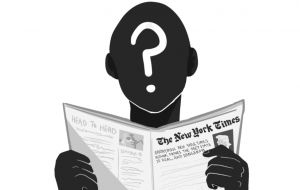Anonymity puts the truth in question
October 24, 2018
A recent New York Times op-ed written by a senior White House official in President Trump’s cabinet has divided Americans due to its anonymous authorship. The writer stated that he or she was a part of a resistance against President Trump, covertly making decisions and controlling the president’s impact, citing examples of the president’s reprehensible behavior. The article has brought to light some issues that the public had been previously unaware of. The article’s contents were shocking, which led experts to question whether or not a prestigious newspaper such as The New York Times should publish such a volatile piece of anonymous writing.
Some believe that the article maintains its validity despite the author’s anonymity. Many cite that the senior White House official was wise in protecting his job and himself from retaliation by choosing to remain anonymous. On the other hand, some politicians, both Republicans and Democrats, criticize the article, calling it cowardly and untrustworthy.
Due to the fact that it is anonymous, readers cannot hold the writer accountable for any incorrect information that is published, either intentionally or unintentionally. Additionally, due to shield laws, policies that prevent publications from revealing confidential sources, and the first amendment, these sources are protected from being revealed. The blame falls on the publication instead, which sets a precedent that risks endangering public trust in news sources.
Anonymous sourcing requires great amounts of trust from both the news organization and readers. Readers are required to trust that the publication has adequately vetted the source and that the source has disclosed factual information. At the same time, the publication is required to trust the information that is provided by the anonymous writer. Despite the fact that news sources may use background checks to vet their sources, there is no method to examine the author’s motives. In settings such as the White House, where there is little inside information made public, journalists have little opportunity to verify their source’s claims. The New York Times stated that they relied on a trusted middleman to connect them with the op-ed writer. This is hardly enough evidence to support the notion that the public must trust the words of this writer. On one hand, readers are told to blindly trust the information that they are given. On the other hand, readers are told that they should be cautious when choosing to trust these types of articles due to the fact that they are anonymous opinion pieces. Such advice puts the validity of a news publication in jeopardy. It is important that the public trust its news sources to provide them with factual content, so it is imperative that we are able to hold our providers accountable in the event that the information is incorrect.
More importantly, anonymous sourcing sets a dangerous precedent and leads the journalism community down a very slippery slope. If we should be able to trust anonymous sources just as much as we trust named sources, when do we draw the line? Much of what experts and named sources say can be deemed as incendiary, controversial, or polarizing. If named sources feel that they can be seen as valid as unnamed sources, there is no incentive for them to provide their names. This lack of accountability will put publications’ legitimacy into question.
Such freedom allows for any individual to pen incendiary content. Furthermore, the op-ed paves the way for any whistleblower or opposition member to publish their opinions on a large scale without providing journalists a method of checking the motives. It is impossible to discern what the writer’s motives were behind his article despite the research and vetting that the New York Times has conducted.
Anonymous sourcing has its place in journalism. It has played a key role in bringing to light many controversies and scandals; however, it also has its drawbacks. It deprives readers of the ability to evaluate an article’s accuracy and the writer’s credibility, forcing them to rely on the opinions of a publication’s editor. If unchecked, such methods can very well lead to the discrediting of key media sources especially in the case of anonymous op-eds. Newspapers are not a vehicle for raging protesters, and thus should not be used as such.


